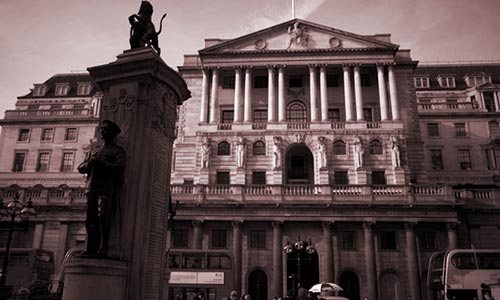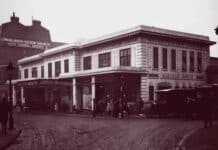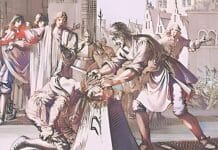ANN MASSEY visits Threadneedle Street, London, and Sarah Whitehead, the Black Nun of the Bank of England.

Since 1694 the Bank of England has been the driving force behind the economy. Created out of necessity following humiliation and defeat in battle at the hands of France, it is the second oldest central bank in the world.
In 1954, an archaeological dig around the Bank’s original foundations discovered a Roman Temple dedicated to Mithras, god of Covenant and Oath, and one wonders if this was entirely coincidental.
As a privately-owned financial institution until the mid-twentieth century, the Bank of England could pretty much buy or sell everyone, remaining in complete control – everyone except for a grief crazed woman by the name of Sarah Whitehead.
It was business as usual for the nineteenth-century staff of the Bank and like all financial environments, it was a victim of employee theft and fraud.
Execution of Philip Whitehead
On 2 November 1811, one such employee, Philip Whitehead was arrested and charged with forgery. His trial took place at the Old Bailey and Philip was found guilty and sentenced to death.
Philip Whitehead was hanged in 1812. As far as the Bank of England was concerned, that was the end of the matter. They hadn’t counted on the appearance of a persistent sibling.
When the young woman entered the banking hall and asked to see her brother, clerks were somewhat taken aback and told Sarah Whitehead that he was away on business. She increased her visits until finally, a member of staff blurted out that Philip had been executed for forgery some time previously.
Black Nun visits Bank of England every day
The sudden shock was enough to send the poor girl spiralling into denial and madness and Sarah visited the Bank every day asking staff if they had seen her brother.
Her attire of a long black dress and full black veil and intense persona was disturbing and distracting for customers and staff alike.
Exasperated, Bank of England officials agreed to pay off the sister of their former employee provided she promised to never set foot in the formidable building as long as she lived.
She kept her promise, but then Sarah died, releasing her from the contract she had made.
Sarah Whitehead was buried in a plot to the rear of the Bank of England, but she was not at rest. No longer bound to her oath, Sarah once again began to haunt those frequenting Threadneedle Street, albeit in a much more literal sense.
For more than two centuries the sorrowful sister has been seen around the Bank of England in her mourning clothes, randomly asking passers-by if they had seen her brother.
Not content with scaring those at ground level, Sarah Whitehead has been seen in the subterranean passageways of Bank Station.
Who is said to haunt the London Underground’s Bank Station?
Bank Station itself has a morbid and horrific history. Originally built on plague pits, the station was bombed in 1941 with a loss of 19 lives.
Commuters have often spoken of an overwhelming sense of despondency and apprehension in the dim walkways and tunnels, with witnesses hearing wailing and moaning echoing along the platforms.
One worker claims to have a chased a woman matching Sarah’s description through the locked station, only for her to have vanished into thin air. Perhaps the tortured souls that remain within Bank Station are kindred spirits for Sarah Whitehead and she feels at home with their eternal angst.
So as you walk the historical locations of Bank Station and Threadneedle Street, keep watch for the Black Nun and if you listen closely you may hear her desperately cry: “Have you seen my brother?”
Tell us if you’ve ever experienced anything creepy at the Bank of England!







